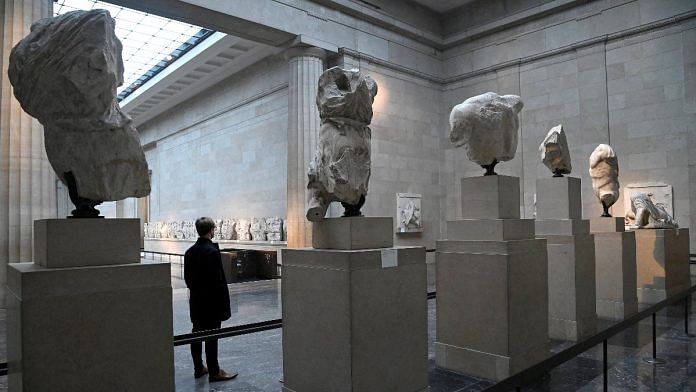New Delhi: The British Museum in London is no stranger to controversy, with citizens of countries formerly colonised by the UK, as well as activists, accusing it of exhibiting “stolen goods”.
But the museum has now courted fresh controversy prompted by a BBC report which revealed that around 2,000 artefacts including gold jewellery and gems, had been stolen from the museum over a period of time.
The recovery process is ongoing, but experts say it could take decades to complete.
The sheer number of goods stolen has left museum officials gobsmacked, with workers stumped as to how an operation of this magnitude could take place in a museum once hailed for its ironclad security. At least one staff member has been sacked, reports said, while museum director Hartwig Fischer has decided to step down from his position.
The 60-year-old German art historian had held the position for seven years.
ThePrint explains the goings-on at the museum, which has been accused by many of being “the world’s largest receiver of stolen goods”.
Also Read: Nehru Museum and Library grew into a record of modern India. New name won’t take that away
Uncatalogued treasures
Founded in 1753, the British Museum is said to be home to around eight million objects, the majority of which are in storage.
Ittai Gradel, a Danish antiquities expert, first alerted the museum to large-scale thefts in 2020, when it was discovered that an entire collection of 942 gems was missing, The Guardian reported. Gradel said he believed the thefts had taken place over two decades and also showed authorities evidence of artefacts being sold on reselling-website e-bay.
The museum has now come under the scanner for purportedly inadequate tracking and registration and cataloguing of goods.
“They (goods) have been lying there without registration for over 200 years, making them an open invitation to theft because who could ever find out,” Gradel told the newspaper.
In 2016, a piece of Roman jewellery made of semi-precious onyx, was posted for sale online with a starting bid of 40 pounds. It didn’t make much of a splash, but it’s true value is now estimated at between 25,000 and 50,000 pounds.
It is one of the artefacts now believed to be stolen from the British Museum.
An official inquiry was reportedly launched two years after the museum authorities were first made aware of the thefts.
While experts say that it is not uncommon for big museums to have lax security measures and registration norms, others argue that in today’s digital age, it is “inexcusable”.
‘Return the goods’
The British Museum’s possession of stolen artefacts has also reignited the argument for those goods to be returned to their countries of origin, which were colonised by the British empire and plundered for their resources.
“The trustees of the British Museum have become the world’s largest receivers of stolen property, and the great majority of their loot is not even on public display,” a report in The Guardian had quoted lawyer and author Geoffrey Robertson as saying in 2014.
Over the years, campaigns have been conducted for the return of some goods, like the Parthenon Marbles, a collection of architectural sculptures allegedly from the temple of Athena, to Greece.
Following reports of the theft at the British Museum, Greece has reportedly renewed its call for return of the sculptures — so far refused by the British government.
Apart from the Parthenon Marbles, the Benin Bronzes are wanted back by Nigeria and the Hoa Hakananai’a by Easter Island.
The British argument for keeping objects of immense cultural significance to other nations is that its guardianship is superior and that it has the kind of resources needed to protect artefacts of priceless value. However, that argument is now coming under fire.
Indian goods in the British Museum include the Amaravati Marbles, a collection of sculptures and inscriptions. They were reportedly shipped to the UK from Madras in 1859.
The Indian argument for repatriation of India’s treasures has been centred around the Kohinoor diamond, a 105.6-carat diamond with a bloody history that was removed from India in the 1850s and is part of the UK Crown Jewels.
Founded in 2014, the India Pride Project is one such group that is working to identify artefacts stolen from India and attempting to secure their return.
(Edited by Nida Fatima Siddiqui)
Also Read: Delhi’s Partition Museum remembers pain of separation—through artefacts, images, personal items



